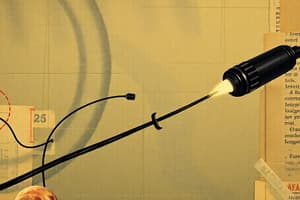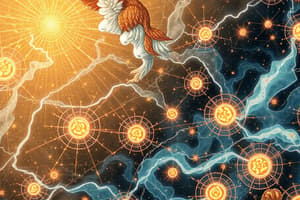Podcast
Questions and Answers
What phenomenon occurs when a magnetic field is created by an electric current flowing through a conductor?
What phenomenon occurs when a magnetic field is created by an electric current flowing through a conductor?
- Electromagnetic induction
- Magnetic effect of electric current (correct)
- Electrostatic force
- Magnetic resonance imaging
What is the direction of the magnetic field created by an electric current flowing from north to south in a conductor?
What is the direction of the magnetic field created by an electric current flowing from north to south in a conductor?
- North to south
- East to west
- West to east
- South to north (correct)
What happens to the strength of the magnetic field with an increase in the electric current through the wire?
What happens to the strength of the magnetic field with an increase in the electric current through the wire?
- Remains constant
- Reverses direction
- Decreases
- Increases (correct)
How can the direction of the magnetic field around a current-carrying conductor be determined?
How can the direction of the magnetic field around a current-carrying conductor be determined?
What does a deflection of a magnetic needle near a current-carrying conductor indicate?
What does a deflection of a magnetic needle near a current-carrying conductor indicate?
What is the equation to calculate the magnetic force on a current-carrying conductor?
What is the equation to calculate the magnetic force on a current-carrying conductor?
What practical application uses the magnetic effect of electric current to generate a magnetic field when an electric current is passed through it?
What practical application uses the magnetic effect of electric current to generate a magnetic field when an electric current is passed through it?
What device works on the principle of electromagnetic induction by rotating a coil in a magnetic field to induce an electric current?
What device works on the principle of electromagnetic induction by rotating a coil in a magnetic field to induce an electric current?
When a current-carrying conductor is placed in a magnetic field, what type of force does it experience?
When a current-carrying conductor is placed in a magnetic field, what type of force does it experience?
What are the practical applications of electromagnets?
What are the practical applications of electromagnets?
Flashcards are hidden until you start studying
Study Notes
Magnetic Effect of Electric Current
The magnetic effect of electric current is a phenomenon in which a magnetic field is created by an electric current flowing through a conductor. This magnetic field exerts a force on other nearby moving charges and magnetic dipoles. In this article, we will discuss the magnetic force on a current-carrying conductor and its implications.
Magnetic Field due to a Current-Carrying Conductor
When an electric current flows through a straight conductor, it creates a magnetic field around the conductor. The direction of the magnetic field depends on the direction of the electric current. For example, if the electric current flows from north to south, the magnetic field lines will be directed from the south pole to the north pole of the conductor. The magnetic field has both magnitude and direction, and its strength increases with the increase in the electric current through the wire.
To visualize the magnetic field around a current-carrying conductor, imagine a straight conductor with a electric current flowing through it. If you place a magnetic needle near the conductor, it will show deflection, indicating the presence of a magnetic field. The direction of the magnetic field can be determined using the right-hand rule or Fleming's left-hand rule.
Magnetic Forces on a Current-Carrying Conductor
The magnetic force on a current-carrying conductor can be calculated using the following equation:
$$F = \frac{I N I}{c}$$
where $$F$$ is the force on the conductor, $$I$$ is the electric current flowing through the conductor, $$N$$ is the number of turns in the coil, and $$c$$ is the speed of light in a vacuum.
When a current-carrying conductor is placed in a magnetic field, it experiences a torque or a force perpendicular to the plane of the conductor. This force can be used to create electromagnets and other magnetic devices.
Applications of Magnetic Effect of Electric Current
The magnetic effect of electric current has various practical applications, including:
-
Electromagnets: Electromagnets are devices that generate a magnetic field when an electric current is passed through them. They are widely used in industry for applications such as lifting, transporting, and sorting materials.
-
Transformers: Transformers are devices that can step up or step down the voltage of an electric current. They use the magnetic effect of electric current to achieve this.
-
Generators: Generators work on the principle of electromagnetic induction. When a coil is rotated in a magnetic field, an electric current is induced in the coil, which can then be used to power devices and appliances.
In conclusion, the magnetic effect of electric current is a fundamental concept in electromagnetism and has numerous applications in various fields, including power generation, transportation, and manufacturing.
Studying That Suits You
Use AI to generate personalized quizzes and flashcards to suit your learning preferences.




